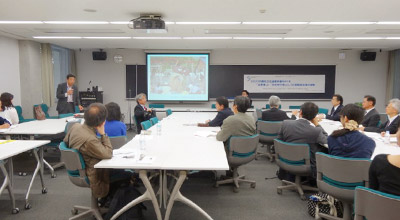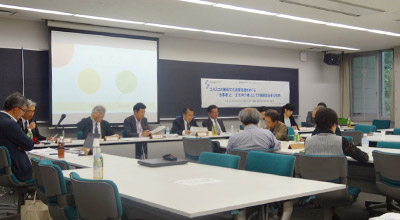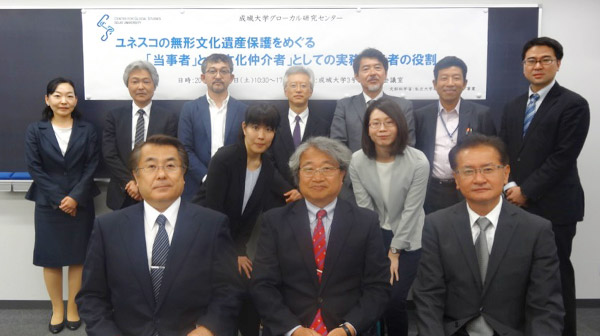

NEWS
2017.08.29
<Synopsis>
On Saturday, May 13, 2017, 13:00–17:00, Seijo University’s Center for Glocal Studies held an open symposium, titled “The Roles of Communities, Groups, and Individuals (CGIs) and Cultural Coordinators in the UNESCO World Heritage,” in Room 3, Building No. 3 of the university campus. The event was part of Seijo University’s project to “establish and promote a world-leading glocal-studies center that contributes toward a sustainable and inclusive society” (a MEXT-supported Research Branding Program for Private Universities). The schedule of the event is shown below, along with the speakers, themes, and coordinator (for more details, see http://www.seijo.ac.jp/events/jtmo42000000gxus.html).
<Schedule>
Opening Address and Outline of Proceedings
10:30-10:50 Tomiyuki Uesugi (Director of the Center for Glocal Studies, Seijo University)
Part 1: Presentations Moderator: Hideo Kato (Institute of Folklore Studies, Seijo University)
10:50 - 11:20 Presentation 1
Hisataka Sato (Mishimura Board of Education)
“Designation of Satsuma Iojima Mendon as an Important Cultural Property and its UNESCO Nomination”
11:20 - 11:50 Presentation 2
Hiroyuki Shimizu (formerly worked at Hitachi City Museum, now works at Ibaraki Christian University)
“The Hitachi Float Procession and the Preservation of Cultural Heritage: What are the Roles of CGIs and Curators?”
11:50 - 12:20 Presentation 3
Seiichi Nakajima (formerly worked at Nagahama Hikiyama Museum, now works at Seian University of Arts and Design)
“Nagahama Hikiyama Museum and Hikiyama Matsuri: Are Museums the Leading Actors in Protecting Intangible Cultural Heritage?”
(12:20 - 13:30 Lunch Break)
13:30 - 14:00 Presentation 4
Ai Numata (Sendai Board of Education)
“The Role of Administrators in Protecting Akiu no Taue Odori”
14:00 - 14:30 Presentation 5
Kyoko Matsui (formerly worked at Kitahiroshima Museum of Geihoku Folk Performing Arts and Folklore, now works at Gifu City Museum of History)
“From What Perspective Should We View Intangible Cultural Heritage? Focusing on Mibu no Hana Taue”
14:30 - 15:00 Presentation 6
Tadayoshi Murakami (Kyoto History Museum)
“The Ten Years Leading up to the Listing of ‘Yamaboko Floats of the Kyoto Gion Matsuri’ and ‘Yama, Hoko, Yatai, Float Festivals in Japan’”
(15:00 - 15:15 Break)
Part 2: Commentary and General Discussion Moderator: Satoru Hyoki
15:15 - 15:30 Commentary 1: Minory Kobayashi (Chief Senior Specialist for Cultural Properties, Agency for Cultural Affairs)
15:30 - 15:45 Commentary 2: Shota Fukuoka (National Museum of Ethnology)
15:45 - 16:50 General Discussion
Closing Address
16:50 - 17:00 Tomiyuki Uesugi
18:00 - 20:00 Informal Gathering (small lecture hall, Floor 3, Building 3)
<Report>
Tomiyuki Uesugi (head of the Center for Glocal Studies) began the proceedings by outlining the purpose of the symposium. Uesugi’s address was followed by presentations on six cases concerning cultural properties that have been or are scheduled to be included in UNESCO’s Representative List of the Intangible Cultural Heritage of Humanity. The presentations were delivered by individuals who were or are currently involved in the listing process.
The first presentation was delivered by Hisataka Sato, who administered cultural heritage in his capacity as a member of the Mishimura Board of Education. Sato described the Hassaku drum dance that accompanies the Satsuma Iojima Mendon festival. He also explained the background for the national designation of “Satsuma Iojima Mendon” as an Important Cultural Property, and the nomination of “Raiho-shin, Ritual Visits of Deities in Masks” for the Representative List of the Intangible Cultural Heritage of Humanity.
The next speaker was Hiroyuki Shimizu (formerly worked at Hitachi City Museum, now works at Ibaraki Christian University), who spoke about the facts concerning the safeguarding of Intangible Cultural Heritage (ICH) and the role of museum curators in the administration of the Hitachi Float Procession, which was listed as a component of “Yama, Hoko, Yatai, Float Festivals in Japan.”
Next, Seiichi Nakajima (formerly worked at Nagahama Hikiyama Museum, now works at Seian University of Arts and Design) discussed the important role that the Nagahama Hikiyama Museum plays, and the challenges it faces in preserving the Nagahama Hikiyama Festival (listed as “Floats of the Nagahama Hikiyama Festival,” a component of “Yama, Hoko, Yatai, Float Festivals in Japan”).
Following the lunch break, Ai Numata (a member of the Sendai Board of Education in charge of cultural property) discussed the 2009 inclusion of Akiu no Taue Odori (a rice-planting dance in Akiu) on the Representative List of the Intangible Cultural Heritage of Humanity, and its impact on the dance itself and on the inter-generational transmission of the same. Numata also discussed the roles that officials in charge should play in administrating cultural heritage.
The next speaker was Kyoko Matsui (formerly worked at Kitahiroshima Museum of Geihoku Folk Performing Arts and Folklore, now works at Gifu City Museum of History), who spoke about the preservation of Mibu no Hana Taue, a rice-planting ritual in Mibu, Kitahiroshima, which was added to the Representative List of the Intangible Cultural Heritage of Humanity in 2011. According to Matsui, the variety of perspectives and circumstances generates differences in how people regard their ICH, including the ICH itself and the scope of the CGIs. She then argued that administrative personnel have a responsibility to act as “cultural mediators” by mediating between these differences.
The next presentation was by Tadayoshi Murakami (Kyoto History Museum), who shared his experience as someone involved in the administration of Kyoto City’s ICH. Murakami discussed the background of the two separate listings of Kyoto’s Gion Matsuri festival. “Yamaboko Floats of the Kyoto Gion Matsuri” was added to the Representative List of the Intangible Cultural Heritage of Humanity in 2009. In 2016, the same ICH was listed once more, this time as a component of “Yama, Hoko, Yatai, Float Festivals in Japan” (re-listed as “Yamaboko Floats of the Kyoto Gion Matsuri”). According to Murakami, in the interval between the two listings, there were subtle changes in Japan’s policy and administrative practices on cultural heritage.
Following these six presentations, the symposium moved into its second part, which consisted of commentary and a general discussion. The first commentator was Minoru Kobayashi (Chief Senior Specialist for Cultural Properties, Agency for Cultural Affairs), who offered his insights into the Japanese Government’s administration of ICH. The second was Shota Fukuoka (National Museum of Ethnology), who offered his insights into the preservation of ICH (particularly those listed by UNESCO) around the world.
During the general discussion, the presenters, commentators, and other attendees—who included researchers and academicians involved in the safeguarding of ICH—spiritedly discussed the roles of local authorities, boards of education, and museum curators in the preservation of ICH, as well as the challenges these actors face. The discussion reaffirmed the vital and proactive role these actors play in administering ICH.
Hisataka Sato proposed a way to further clarify the roles of these administrators. Specifically, he argued that one should avoid referring to them as “cultural mediators” or “cultural coordinators,” as this suggests neutrality. Instead, he asserted, they should be called “cultural facilitators,” to underscore their agency and proactivity in the process. Tadayoshi Murakami raised the point that, in the process of preserving ICH, the conceptual nuances and scope of the CGIs (as defined in UNESCO’s Convention for the Safeguarding of the Intangible Cultural Heritage) tend to be arbitrarily reinterpreted/manipulated to suit convenience and circumstances.
The symposium broke new ground in that it focused attention for the first time on the roles and value of local authorities, boards of education, and museum curators in the preservation of intangible cultural heritage.



Attendees at the Symposium